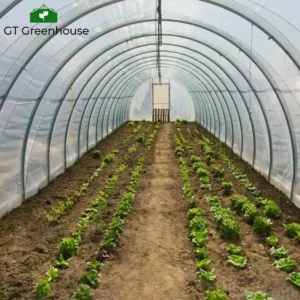Agricultural greenhouse tunnels have emerged as a revolutionary technology in modern farming practices. These structures offer a cost-effective and efficient solution for extending the growing season, protecting crops from adverse weather conditions, and improving overall yield. In this article, we will explore the concept of agricultural greenhouse tunnels, their key features, and the significant advantages they bring to crop cultivation.
I. Understanding Agricultural Greenhouse Tunnels
- Structure and Design:
Agricultural greenhouse tunnels are low-profile structures made of lightweight materials such as metal or PVC pipes, covered with a durable and transparent plastic film. The design resembles a tunnel-shaped structure, hence the name. The plastic cover allows sunlight to enter while creating a controlled environment for optimal plant growth. - Versatility:
Greenhouse tunnels are versatile and adaptable, suitable for various crop types, including vegetables, flowers, and small fruits. They can be customized in size and shape to meet specific farming requirements and can be easily relocated or expanded as needed.
II. Advantages of Agricultural Greenhouse Tunnels
- Season Extension:
Greenhouse tunnels enable farmers to extend the growing season by creating a protected environment for plants. By shielding crops from frost, wind, and excessive rain, farmers can start cultivation earlier in the spring and continue production later into the fall, maximizing crop yield and profitability. - Climate Control:
Agricultural greenhouse tunnels provide a controlled microclimate for plants. The plastic cover traps heat inside, creating a warmer environment ideal for heat-loving crops. Additionally, ventilation systems can be integrated into the tunnels to regulate temperature, humidity, and airflow, ensuring optimal growing conditions. - Protection from Extreme Weather:
Greenhouse tunnels act as a shield against extreme weather events such as hailstorms, heavy rain, and strong winds. The plastic cover protects crops from physical damage, preventing yield loss and reducing the risk of crop failure. - Pest and Disease Management:
The enclosed environment of greenhouse tunnels acts as a barrier against pests, insects, and plant diseases. This reduces the reliance on chemical pesticides, promoting more sustainable and environmentally friendly farming practices. - Water Conservation:
Greenhouse tunnels minimize water consumption by reducing evaporation and shielding crops from heavy rainfall. Irrigation systems can be installed within the tunnels, allowing precise water application directly to the plants’ root zones, optimizing water usage and reducing waste. - Increased Crop Yield and Quality:
The controlled environment provided by greenhouse tunnels enhances crop growth, resulting in higher yields and improved crop quality. The consistent temperature, humidity, and light conditions promote uniform growth, reduce stress on plants, and facilitate optimal nutrient uptake. - Cost-Effectiveness:
Agricultural greenhouse tunnels offer a cost-effective alternative to traditional greenhouse structures. They require less initial investment and maintenance compared to larger-scale greenhouses, making them accessible to small-scale farmers and growers with limited resources.
Agricultural greenhouse tunnels have revolutionized crop cultivation by providing a controlled and protected environment for plants. With their versatility, season-extending capabilities, climate control features, greenhouse tunnel for agriculture and protection against extreme weather and pests, these tunnels offer numerous advantages for growers. By optimizing crop yield, reducing water consumption, and improving crop quality, agricultural greenhouse tunnels are shaping the future of sustainable and efficient farming practices.
